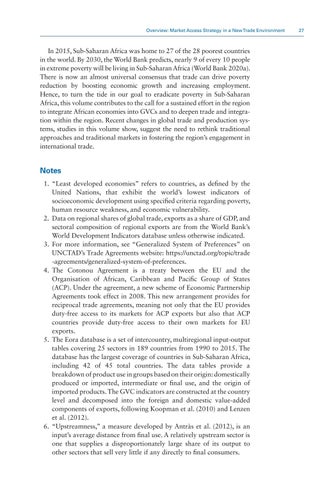Overview: Market Access Strategy in a New Trade Environment 27
In 2015, Sub-Saharan Africa was home to 27 of the 28 poorest countries in the world. By 2030, the World Bank predicts, nearly 9 of every 10 people in extreme poverty will be living in Sub-Saharan Africa (World Bank 2020a). There is now an almost universal consensus that trade can drive poverty reduction by boosting economic growth and increasing employment. Hence, to turn the tide in our goal to eradicate poverty in Sub-Saharan Africa, this volume contributes to the call for a sustained effort in the region to integrate African economies into GVCs and to deepen trade and integration within the region. Recent changes in global trade and production systems, studies in this volume show, suggest the need to rethink traditional approaches and traditional markets in fostering the region’s engagement in international trade.
Notes 1. “Least developed economies” refers to countries, as defined by the United Nations, that exhibit the world’s lowest indicators of socioeconomic development using specified criteria regarding poverty, human resource weakness, and economic vulnerability. 2. Data on regional shares of global trade, exports as a share of GDP, and sectoral composition of regional exports are from the World Bank’s World Development Indicators database unless otherwise indicated. 3. For more information, see “Generalized System of Preferences” on UNCTAD’s Trade Agreements website: https://unctad.org/topic/trade -agreements/generalized-system-of-preferences. 4. The Cotonou Agreement is a treaty between the EU and the Organisation of African, Caribbean and Pacific Group of States (ACP). Under the agreement, a new scheme of Economic Partnership Agreements took effect in 2008. This new arrangement provides for reciprocal trade agreements, meaning not only that the EU provides duty-free access to its markets for ACP exports but also that ACP countries provide duty-free access to their own markets for EU exports. 5. The Eora database is a set of intercountry, multiregional input-output tables covering 25 sectors in 189 countries from 1990 to 2015. The database has the largest coverage of countries in Sub-Saharan Africa, including 42 of 45 total countries. The data tables provide a breakdown of product use in groups based on their origin: domestically produced or imported, intermediate or final use, and the origin of imported products. The GVC indicators are constructed at the country level and decomposed into the foreign and domestic value-added components of exports, following Koopman et al. (2010) and Lenzen et al. (2012). 6. “Upstreamness,” a measure developed by Antràs et al. (2012), is an input’s average distance from final use. A relatively upstream sector is one that supplies a disproportionately large share of its output to other sectors that sell very little if any directly to final consumers.


